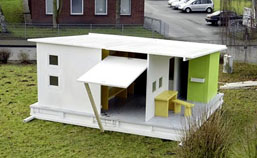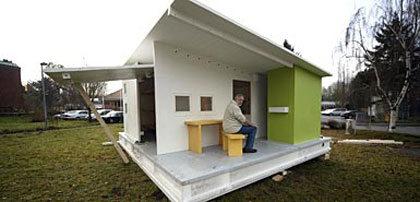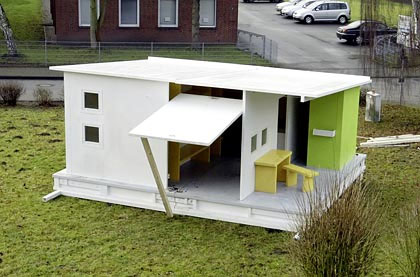NEWS
GENERAL

10 February, 2009
The Wall paper house offers cheap dry home for poor and displaced
The house has built-in single and double beds and a veranda with a sealed-off area housing a shower and lavatory. 
The property market is in the doldrums, mortgages are elusive but there is still some hope for the first-time buyer: the paper house.
Retailing for about $5,000 (£3,375), the house is supposed to brighten up Third World shantytowns and provide quick shelter for long-term refugees. The Universal World House can be used almost anywhere: light, easily assembled, environmentally friendly, earthquake-proof and, crucially in the age of recession, a bit of a bargain.

Gerd Niemoeller, its inventor, says that the 36sq m paper house weighs barely 800kg (1,763lb) — lighter than a VW Golf. “Without the foundation block, the whole house actually weighs in at about 400kg,” says the design engineer. It will not, however, simply blow away. The basic material is resin-soaked cellulose recovered from recycled cardboard and newspapers.
Add heat and pressure and the paper becomes extremely stable. The interior of the prefabricated building panels resemble honeycombs; an air vacuum fills each of the units. The result: a strong and stable exterior wall, well insulated. A similar construction technique is used in aircraft and high-speed yachts.

“But they are working with aluminium and other alloys, which is expensive, time consuming, energy intensive,” said Mr Niemoeller, who has patented the invention under the name of his Swiss-based company The Wall AG. “That’s not suitable for the Third World.” The prime purpose is to create intelligent housing settlements almost instantly for the displaced and the urban poor.
“People don’t want to flee their countries, they’ve been driven to leave their homes out of the need to survive,” said the 58-year-old engineer. “The number of migrants, refugees living in improvised housing, is going to grow with climate change, and we offer an alternative.” An alternative, that is, to the corrugated-iron sheds and lean-tos so often seen in the slums of the developing world.
The house has eight built-in single and double beds and a veranda with a sealed-off area housing a shower and a lavatory. It has been designed together with the German development aid agency GTZ, and with the architect Dirk Donath, from the Bauhaus University in Weimar.
Apart from the sleeping area, there are shelves, a table and benches. “It has been designed so that a family can slaughter an animal on the veranda, wash it in the shower and hang it, along with fish, on an integrated washing line.” The whole wall of the kitchen can be tipped open to let air in and to blur the distinction between inside and outside.
First inquiries have come from the Delta State oil developers in Nigeria, and from Angola. More than 2,000 houses have been ordered by another Nigerian company. Development aid agencies are considering whether the houses could be used to accommodate those fleeing from the cholera epidemic in Zimbabwe. South America, too, is interested.
The aim is to build the machines in northern Germany, near Kiel, and then send them, along with the raw materials, to the target country. The houses are then put together on the spot, creating local jobs and reducing transport costs.
But there is no reason why the paper houses should not be used in Europe.
The panels are rain resistant — and it is not compulsory to butcher a goat on the veranda.
Roger Boyes in Berlin
timesonline.co.uk
Related articles:
- Theaterhaus Jena Inflatable Pavilion ( 25 September, 2009 )
- Norway-Powered by Nature ( 26 September, 2011 )
- Transportable unit of medical support for central Africa ( 02 February, 2011 )
- Beehive housing ( 30 October, 2010 )
- Container (s) ( 17 April, 2012 )
- Time-Bank Local Complex ( 04 March, 2013 )
- Urban Camping. Athens ( 28 April, 2013 )
- b84 ( 15 October, 2013 )
- TV ( 22 January, 2014 )
- Multiplying the ''Joint'' ( 06 March, 2015 )
- Designing for the homeless ( 26 March, 2015 )
- T.E.F.K. House ( 30 March, 2015 )










